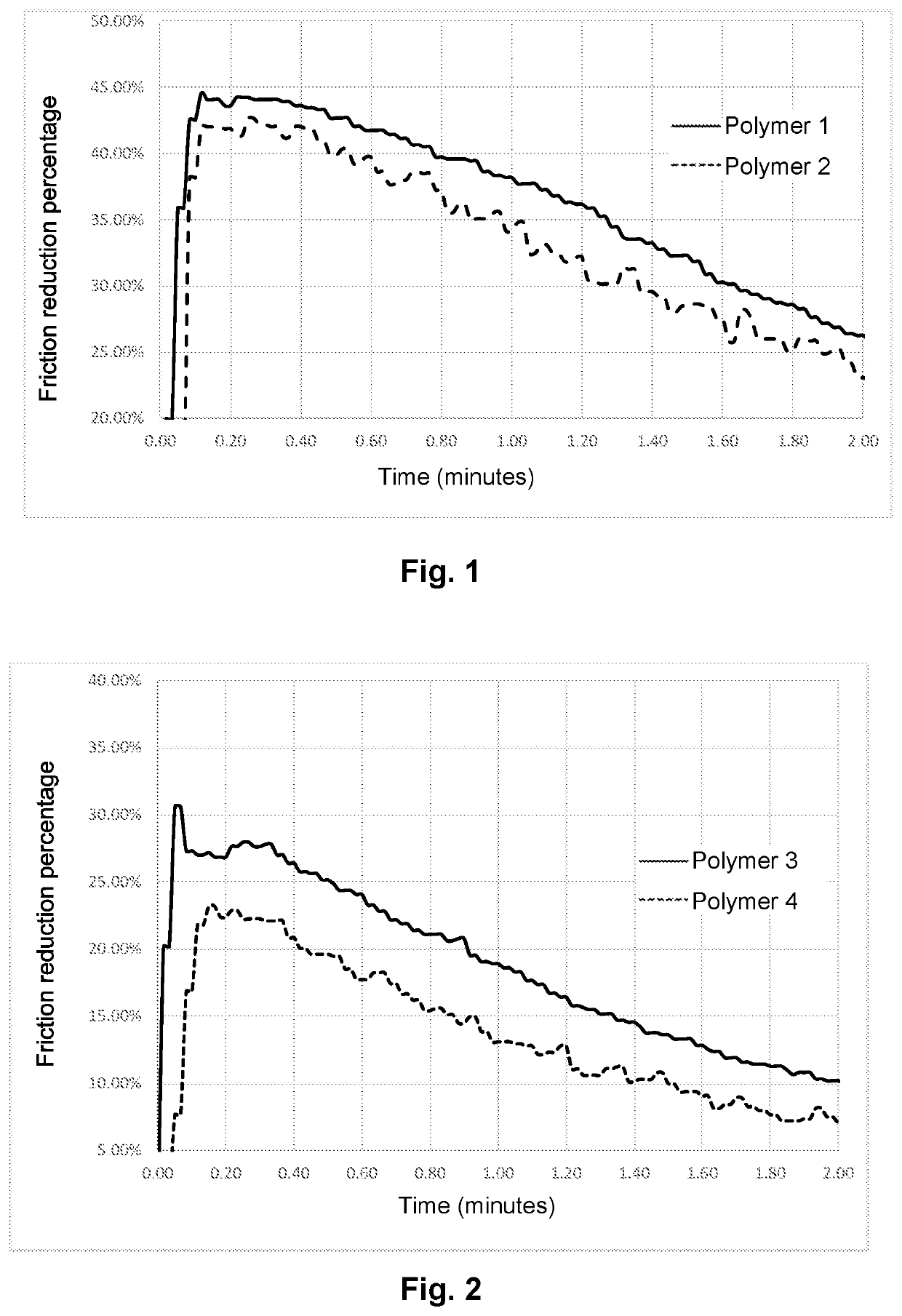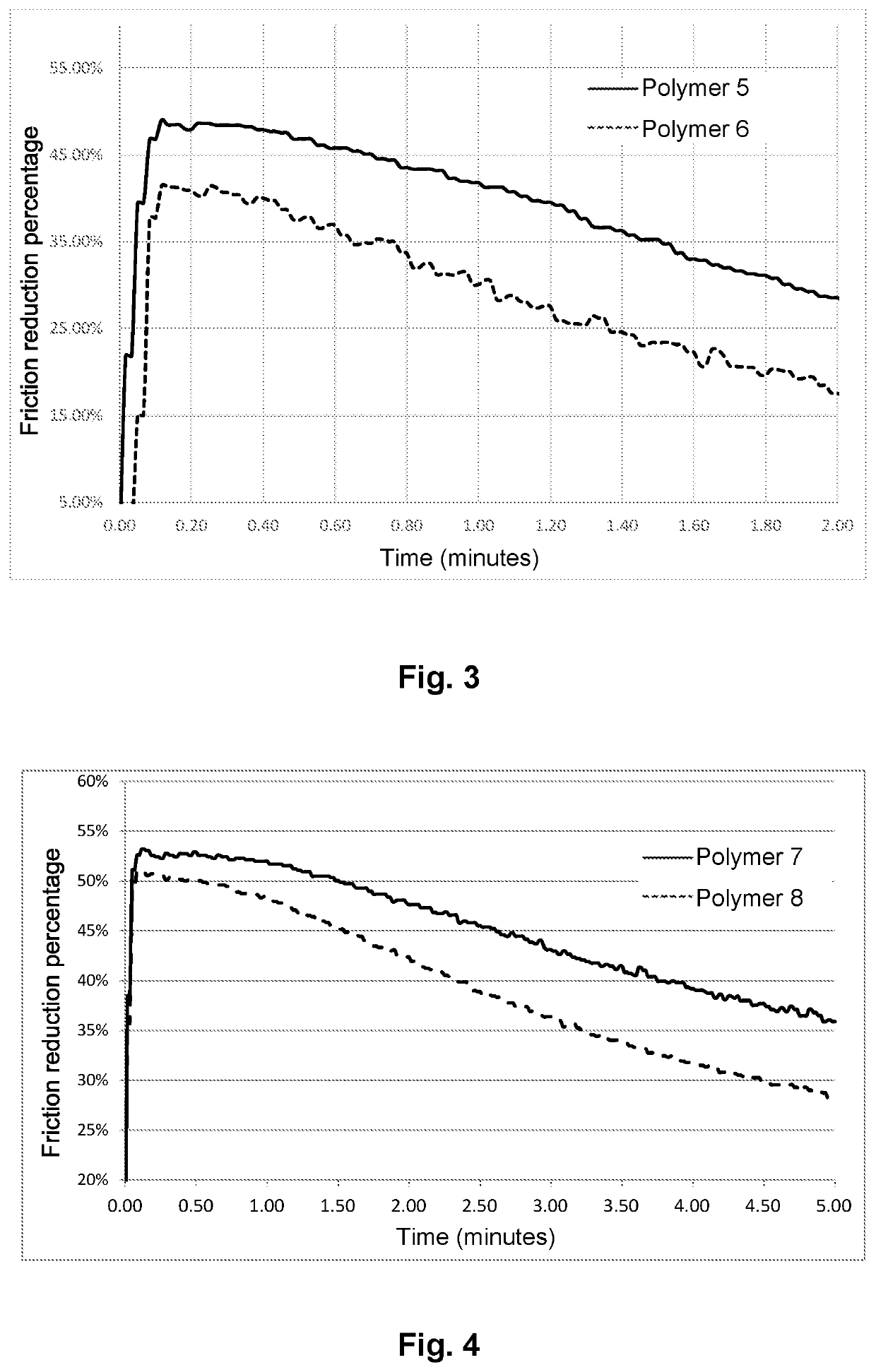Fracturing fluid comprising a (CO)polymer of a hydrated crystalline form of 2-acrylamido-2-methylpropane sulphonic acid and hydraulic fracturing method
a technology of hydration crystalline form and hydraulic fracturing method, which is applied in the direction of quarries waste water treatment, organic chemistry, borehole/well accessories, etc., can solve the problems of limiting production, gas or oil contained in unconventional reservoirs cannot easily migrate from the rock to the well without stimulation, and water alone cannot suffice for effective propping
- Summary
- Abstract
- Description
- Claims
- Application Information
AI Technical Summary
Benefits of technology
Problems solved by technology
Method used
Image
Examples
examples
Polymer Synthesis
Polymers 1 and 2 (Post-Hydrolyzed ATBS / Acrylamide Copolymers)
Polymer 1 (ATBS in Hydrated Crystalline Form)
[0133]To a 2000 mL beaker are added 761.9 g of deionized water, 574.2 g of 50% acrylamide solution, 35.9 g of 50% sodium hydroxide, 11.7 g of urea and 116.3 g crystals of 2-acrylamido-2-methylpropane sulfonic acid (hydrated crystalline form).
[0134]The resulting solution is cooled between 0 and 5° C. and transferred to an adiabatic polymerization reactor, then nitrogen is bubbled for 30 minutes to remove all traces of dissolved oxygen.
[0135]The following are then added to the reactor:[0136]0.45 g of 2,2′-azobisisobutyronitrile,[0137]1.5 mL of a 5 g / L solution of 2,2′-azobis[2-(2-imidazolin-2-yl)propane] dihydrochloride,[0138]1.5 mL of a solution at 1 g / L of sodium hypophosphite,[0139]2.25 mL of a solution at 1 g / L of tert-butyl hydroperoxide,[0140]3.0 mL of a solution at 1 g / L of ammonium iron (II) sulfate hexahydrate (Mohr's salt).
[0141]After a few minutes, the ...
example 2
on of Fracturation Fluids
[0178]Polymers 1 to 8 in powder form are dissolved with stirring at a concentration of 10,000 ppm in a brine composed of water, 85 g of sodium chloride (NaCl) and 33.1 g of calcium chloride (CaCl2), 2H2O) per liter of brine.
[0179]The resulting saline polymer solutions are then injected into a 0.05 pptg concentration into brine recirculating for the Flow Loop tests that follow.
example 3
Friction Reduction Tests
[0180]To evaluate the friction reduction for each of polymers 1 to 8, the reservoir in the flow loop was filled with 20 L of brine (brine described in example 2). The brine is then recirculated in the flow loop at a rate of 24 gallons per minute. The polymer is added at a concentration of 0.5 pptg in the recirculated brine. The friction reduction percentage is then determined using measurement of pressure variations measured inside the flow loop.
FIGS. 1 to 4:
[0181]FIGS. 1 to 4 are graphics showing the percentage of friction reduction as a function of time for each type of polymer. (FIG. 1: post hydrolyzed, FIG. 2: terpolymers, FIG. 3: copolymers, FIG. 4: homopolymers)
[0182]These figures show that the injection fluids according to the invention produce improved friction. Indeed, when the polymers contain ATBS in hydrated crystalline form, the friction reduction is better.
PUM
| Property | Measurement | Unit |
|---|---|---|
| particle size | aaaaa | aaaaa |
| size | aaaaa | aaaaa |
| size | aaaaa | aaaaa |
Abstract
Description
Claims
Application Information
 Login to View More
Login to View More - R&D
- Intellectual Property
- Life Sciences
- Materials
- Tech Scout
- Unparalleled Data Quality
- Higher Quality Content
- 60% Fewer Hallucinations
Browse by: Latest US Patents, China's latest patents, Technical Efficacy Thesaurus, Application Domain, Technology Topic, Popular Technical Reports.
© 2025 PatSnap. All rights reserved.Legal|Privacy policy|Modern Slavery Act Transparency Statement|Sitemap|About US| Contact US: help@patsnap.com


